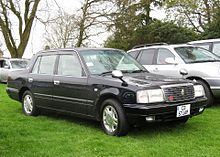Japanese used vehicle exporting
[citation needed] The most popular destinations for used cars from Japan are Antigua and Barbuda, Australia, Bahamas, Bangladesh, Barbados, Brunei, Cambodia, Canada, Dominica, Eswatini, Georgia, Grenada, Guyana, Hong Kong, Indonesia, Ireland, Jamaica, Kazakhstan, Kenya, Laos, Lesotho, Malawi, Malaysia, Mauritius, Mongolia, Mozambique, Myanmar, New Zealand, Pakistan, Russia, Saint Kitts and Nevis, Saint Lucia, Saint Vincent and the Grenadines, Sri Lanka, Suriname, Tanzania, Thailand, Trinidad and Tobago, Uganda, United Kingdom, Zambia, and Zimbabwe.Additionally, Chile, South Africa, Singapore, and the United Arab Emirates are used as popular transit hubs.This includes de-registering the vehicle with the government, getting an export certificate, and cleaning the car to remove biosecurity risks.Car cleaning is especially necessary for the Australian Quarantine and Inspection Service (AQIS)[4] and New Zealand's Ministry of Primary Industries (MPI)[5] agencies' clearances.[9][10][11] They often lack structural reinforcements needed to meet side-impact crashworthiness standards in effect outside Japan.[12][13] Generally, most exporters are responsible for the organization and completion of the vehicle's transportation until it arrives at the importer's Port of Destination (POD).The importation of used private cars, microbuses, SUVs, and jeeps is restricted to vehicles not older than five years from the date of manufacture.Imported vehicles typically enter through the Chattogram or Mongla ports and must be registered with the Bangladesh Road Transport Authority (BRTA) following a roadworthiness test.The Cayman Islands government announced on May 1, 2023 that the cabinet approved, on April 25, 2023, changes in Customs and Border Control (Prohibited Goods) (Amendment) Order, 2023 that restrict the importation of used vehicles from 2016 to 2023.[16] In Chile, second hand imported vehicles may only be registered in the extreme regions of Arica and Parinacota, Tarapacá, Aisén and Magallanes.However, a big market of non converted cars exists in the duty-free zone of Iquique, where customers from other countries buy them and sometimes drive them home.If a Japanese used car is fitted with privacy windows, it must be converted to clear glass in order to be registered in Hong Kong.In the case of cars imported from Japan, all glass, tyres, noise, must meet EU approved levels.The customs clearance amount will depend on the type of car, engine size, number of seats and propose of use, and can cost up to 84% of the CIF of the Vehicle.Although a prohibitively high import tariff is levied on cars more than seven years old, to protect local industry, the oldest Japanese vehicles usually pass the inspection, if they were well maintained.











Toyota Crown S170United Kingdomgrey marketinternational tradeexportused carsmotor-vehicle inspectionsdepreciationAntigua and BarbudaAustraliaBahamasBangladeshBarbadosBruneiCambodiaCanadaDominicaEswatiniGeorgiaGrenadaGuyanaHong KongIndonesiaIrelandJamaicaKazakhstanLesothoMalawiMalaysiaMauritiusMongoliaMozambiqueMyanmarNew ZealandPakistanRussiaSaint Kitts and NevisSaint LuciaSaint Vincent and the GrenadinesSri LankaSurinameTanzaniaThailandTrinidad and TobagoUgandaZambiaZimbabweSouth AfricaSingaporeUnited Arab Emiratesauto auctionsbiosecurityAustralian Quarantine and Inspection ServiceMinistry of Primary Industries (MPI)containerright-hand drivesteering wheelautomobile safetyECE RegulationsNorth American regulationsUnited Stateswindshieldsseat beltslamps and reflectorsmirrorscrashworthinessbumpersKei carsIncotermsHonda S660Nissan CefiroAlbertaheadlampsother lights and reflectorsToyota CorollaArica and ParinacotaTarapacáAisénMagallanesleft hand driveIquiqueGreeceToyota bBgasolineEuro VIcunleaded-fuelToyota WiLLDublinNational Car TestHonda BeatToyota istToyotaIntertekToyota SprinterSeverskright hand trafficNorth KoreaCentral AsiaHonda ShuttleToyota FortunerToyota HiaceNissan Skyline R34Toyota Comfortspeedometerrear fog lightNissan GT-RConnecticutFederal Motor Vehicle Safety Standardskei trucksutility vehiclesInterstate highwaysWayback Machine
